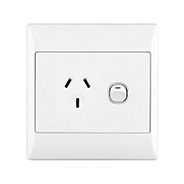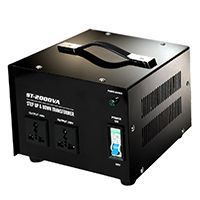Which plug adapter do I need for using a curling iron in New Zealand?
Summary
First check that your curling iron can handle the voltage in New Zealand:
- If your curling iron can run using 230 volts or can support dual voltage (how you can check) then you'll only need to bring a suitable power adapter for New Zealand listed on this page if the plug on your curling iron won't fit.
If not then:
- Use a dual voltage travel curling iron [2] - you may still need a power adapter for New Zealand however these cheap lightweight accessories are designed specifically for travel.
- Use a power converter (or voltage transformer) - this will enable you to use your existing curling iron and other applicances with a 230 volt New Zealand power outlet, however this is noticeably bulkier and more expensive than a dedicated travel curling iron. A power converter will change the voltage but not the actual physical shape of the plug on your curling iron to fit in the types of wall outlet used in New Zealand, so please check that your power converter comes with the correct power adapter for New Zealand otherwise you will need to bring another power adapter. Note - your existing curling iron might not be suitable for travelling and you could risk potential damage in transit. [5] [AD]
Using a curling iron in New Zealand
Will my curling iron work in New Zealand?
This will depend on if your curling iron can operate using the 230 volt power outlets in New Zealand:
- If you're using either a dual voltage curling iron or your curling iron can operate using 230 volts and you have the correct plug adapter then you should be able to use the curling iron in New Zealand.
- If not then then you will need to consider bringing either a dual voltage travel curling iron [2] or a heavier and more expensive power converter. Read our section on can you use a voltage converter with a curling iron in New Zealand for help deciding which solution is more suitable. [5] [AD]
Will my American curling iron work in New Zealand?
The guides on this page assume that you are a reader from America visiting New Zealand and will provide guidance for using your US curling iron with a New Zealand power outlet.
New Zealand power outlets and plug sockets
What is the mains voltage in New Zealand?
The standard residential voltage used in New Zealand is 230 volts.
What electrical frequency is used with a New Zealand power outlet?
The frequency from a New Zealand power outlet is 50 Hz. [6]

Type I power outlet
Which plug adapter do you need for using a curling iron in New Zealand?
The type of power outlet used in New Zealand is type I. You can identify this wall outlet by 3 slots forming a triangular pattern with a single vertical pin at the bottom and the top pair of slots sloping upwards for the live, neutral and earth. A suitable plug adapter to bring to use a 230 volt curling iron in New Zealand is a Type I power adapter - read the simple instructions below for full details of using a curling iron in New Zealand with a travel adapter. Be aware that unless you that have a dual voltage curling iron you will need to see if you need to bring a voltage converter. [4] [7] [AD]
Dual voltage curling irons
Is my curling iron dual voltage?
The way to tell if your curling iron will handle a dual voltage outlet is to look for either a sticker or numbers printed on the plug or handle. This location might depend on the make and model of your curling iron, it should also be written on the box or in the instruction manual. Some dual voltage curling irons can change automatically, however other models will have a switch which allows you to operate between different regions.
- Single voltage could say a specific number - such as 110V. If this number matches the 230 volts used in New Zealand then you should be able to use your curling iron with a New Zealand power outlet.
- Single voltage might also have a small voltage range with a dash to accomodate small voltage fluctuations - such as 100-120V. If the 230 volts used in a New Zealand power outlet falls within the range shown on your curling iron then you can use it in New Zealand.
- Dual voltage will say a large voltage range separated with a slash - such as 100/240V. Your curling iron will be capable of being used in New Zealand or any other country if these numbers are shown.
Travelling to New Zealand with a curling iron
Can curling irons go in hand luggage to New Zealand?
According to the TSA guidelines for curling irons there are no restrictions when carrying a mains powered curling iron in your carry on luggage through airport security in the United States. The TSA also recommends that you should verify that the airline that is taking you to New Zealand will allow curling irons onboard and that it will fit in the overhead bin or underneath the seat of the airplane. Packing the curling irons in a dedicated heat resistant protective hot tools travel case leaves it easily accessible by airport security checks, it can be packed away quickly avoiding a tangle of cables in your carry on luggage (the TSA recommends wrapping wires tightly around electronic items). If you do intend to bring fragile or expensive curling irons in your hand held luggage then it is advisable to use hard carry on luggage as this provides the greatest protection against bumps and knocks during your journey. [8] [9] [10] [AD]
Is it safer to bring your domestic curling iron or dual voltage curling iron to New Zealand?
Packing a dual voltage travel curling iron is preferable to packing your existing curling iron as it ensures that it will work with the 230 volt power outlets used with a New Zealand power outlet, as long as you use the correct power adapter for New Zealand. Note that bringing expensive domestic curling iron could put it at risk due to potential damage or loss in transit by airline baggage handlers in New Zealand. The cost and inconvenience involved in repairing or replacing an expensive specialised curling iron in New Zealand could be more than purchasing a cheap dual voltage travel curling iron [2] before your trip. If you intend to pack your own personal curling iron in your luggage it is recommended to either slot it inside a sneaker or boot to protect from light damage, alternatively use a heat resistant and shockproof hot tools travel case which will also allow the curling iron to be transported right after use without risk of burning. [9] [AD]
Power converters for New Zealand

Voltage converter
What is the difference between a power adapter and a power converter?
A cheap, small and lightweight power adapter (or plug adapter) changes the shape of the plug on your curling iron to slot into a power outlet in New Zealand, whereas a heavy and bulkier power converter transforms a 230 volt New Zealand power outlet to work with a non-230 volt curling iron. [5] [AD]
Do I need a converter to use a curling iron in New Zealand?
A power converter (or voltage transformer) allows your curling iron using a different voltage to work using a 230 volt power outlet used in New Zealand. A power converter is more suitable for travellers who want to use their own domestic curling iron, but it might be a lot cheaper to buy a dedicated dual voltage travel curling iron [2] than it is to buy a power converter. A power converter is substantially bulkier and heavier than a travel curling iron making a power converter less suited for packing. [5] [AD]
How to use a curling iron in New Zealand using a type I power adapter
A step by step guide showing you how to power a curling iron in New Zealand with a Type I power charger.
- Check that your curling iron is either a dual voltage travel curling iron [2] or can work with a 230 volt power outlet but if not then don't attempt these instructions as you could create an electrical fire hazard, damage your iron or blow a fuse. Dual voltage curling irons usually have a switch to toggle between voltages, before operating the iron make sure you have set it to accept 230 volts - please consult the user guide for more details on where this switch is located.
- If the plug on your curling iron isn't the same shape as the outlet used in New Zealand you will need to buy a Type I power adapter [4]. The Type I power adapter will help fit plugs on appliances from other countries for use with an electrical outlet in New Zealand by changing the shape of the plug, but it doesn't change the frequency or voltage of your curling iron to work with a 230 volt outlet.
- Begin by inserting the Type I power adapter in the wall outlet. You can identify this wall supply by 3 slots in a triangular pattern with a single vertical pin at the bottom and the top pair of slots sloping upwards for the live, neutral and earth blades.
- Plug in your curling iron into the Type I power adapter.
- Switch on the New Zealand power outlet.
- The curling iron can now be used in New Zealand. [AD]
See also
External links
We endeavour to ensure that links on this page are periodically checked and correct for suitability. This website may receive commissions for purchases made through links on this page. As an Amazon Associate WikiConnections earn from qualifying purchases. For more details please read the disclaimers page.
- Wikipedia - New Zealand country page on wikipedia.org
- Amazon - dual voltage travel curling iron
- iec.ch - Type I power outlet
- Type I power adapter - A Type I electrical adapter, compliant with AS/NZS 3112, fits in a standard Australia electrical outlet. This adapter features two flat pins in an inverted V-shape with an earthing pin and is also commonly used in New Zealand, China, and Argentina..
- Power converter - Heavy-duty power converters are designed to convert voltage levels between different electrical standards, shifting between 110V/120V and 220V/240V with both 50Hz and 60Hz, often incorporating safety features such as fuse protection and circuit breakers..
- Wikipedia - WikiPedia - Mains electricity by country -
- iec.ch - IEC World Plugs by location -
- tsa.gov - TSA guidelines for curling irons -
- Hard case for hot tools - Hard case designed for storing and protecting a flat irons, curling irons and hair straighteners.
- Hard carry on luggage - Hard carry-on luggage features a tough outer shell to absorb impact and is recommended for transporting heat tools or fragile electronics in overhead bins..
| 2 other devices in this category | |
| Connecting a New Zealand power outlet to: |
|